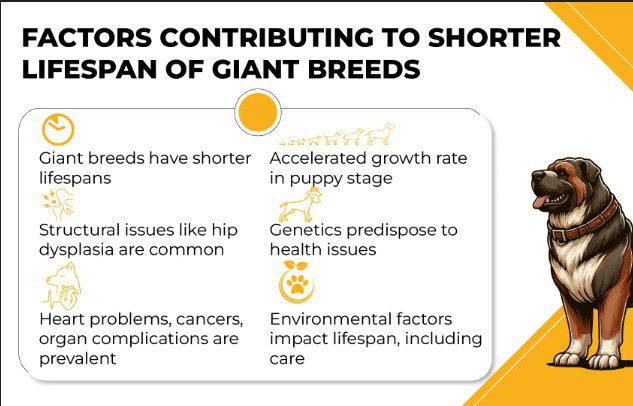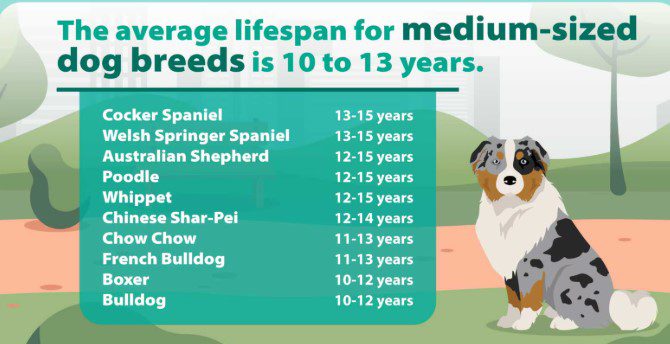Dog Lifespan by Breed: Discover How Long Your Favorite Dog Breeds Live
Introduction
Understanding the lifespan of a dog by breed is essential for current and prospective dog lifespan owners who want to provide the best possible care for their furry companions. Each breed has its own unique traits, including size, genetics, and health tendencies — all of which directly influence how long a dog lifespan is likely to live. While some small breeds like Chihuahuas can live well into their late teens, larger breeds such as Great Danes may only reach 7 to 10 years.
Knowing this information not only helps you choose the right dog for your lifestyle but also prepares you for the long-term commitment that comes with pet ownership. In this guide, we’ll explore the average lifespan of popular dog breeds, explain the factors that impact canine longevity, and offer tips to help extend your dog’s life. Whether you’re a dog lifespan lover or planning to adopt, this information will be invaluable.
Factors That Influence Dog Lifespan

Several key factors play a role in determining how long a dog lives. Genetics is one of the most significant — some breeds are naturally predisposed to longer or shorter lifespans. Size also matters; smaller dog lifespan typically live longer than larger ones. Diet, exercise, and access to regular veterinary care greatly impact a dog’s health and longevity. Environmental factors, such as stress, living conditions, and preventive healthcare, also contribute. Understanding these elements can help you take proactive steps to support your dog’s long and healthy life.
Small Dog Breeds and Their Lifespan
Small dog breeds are known for their longevity, often living between 12 to 18 years. Breeds like the Chihuahua, Toy Poodle, and Yorkshire Terrier are not only adorable but also tend to have fewer age-related issues compared to larger breeds. Their smaller body size reduces strain on joints and organs, which may contribute to their extended lifespan. However, they still require proper care, regular check-ups, and a healthy lifestyle to reach their full life expectancy.
Medium Dog Breeds and Their Lifespan
Medium-sized dog lifespan breeds generally have lifespans ranging from 10 to 14 years. Breeds like Beagles, Cocker Spaniels, and Border Collies fall into this category. They typically enjoy a balance between the longevity of smaller breeds and the strength of larger ones. While many medium dogs are quite healthy, some may be prone to specific conditions like hip dysplasia or heart issues. With proper nutrition, regular exercise, and routine veterinary care, these breeds can live full, active lives well into their senior years.
Large Dog Breeds and Their Lifespan
Large dog lifespan breeds usually have shorter lifespans, averaging around 8 to 12 years. Popular breeds like Golden Retrievers, Labrador Retrievers, and German Shepherds are known for their loyalty and intelligence, but they may face health challenges such as joint problems, heart disease, or cancer as they age. Their larger body mass puts more strain on vital organs and bones, which can impact longevity. Responsible breeding, a nutritious diet, and early medical intervention can significantly improve their quality of life and life expectancy.
Giant Dog Breeds and Their Lifespan

Giant dog breeds, such as Great Danes, Saint Bernards, and Mastiffs, are beloved for their impressive size and gentle nature, but they tend to have the shortest lifespans among all breeds—typically around 6 to 10 years. Their large size contributes to faster aging and increased risk of health problems like heart disease, joint disorders, and certain cancers. Despite their shorter lives, these dogs can thrive with proper nutrition, joint support, and consistent veterinary monitoring. Early detection of issues is key to maximizing their time with you.
Mixed Breeds vs. Purebreds: Who Lives Longer?
When comparing mixed breeds to purebred dog lifespan, mixed breeds often have a slight advantage in lifespan, typically due to greater genetic diversity. This diversity may reduce the risk of inherited conditions that commonly affect purebreds. However, factors like size, care, and overall health history still play a crucial role. While some purebreds are prone to breed-specific health issues, responsible breeding can mitigate many of these risks. Regardless of breed type, attentive care can significantly influence a dog’s longevity and well-being.
Tips to Help Your Dog Live a Longer Life
While genetics play a role, many aspects of your dog’s lifespan are within your control. Providing a balanced, high-quality diet tailored to their age and size is essential. Regular exercise helps maintain a healthy weight and supports heart and joint health. Routine veterinary visits allow for early detection of potential health issues. Mental stimulation, socialization, and a stress-free environment also contribute to overall well-being. By staying proactive and attentive, you can greatly enhance your dog’s quality of life and help them live longer, healthier years.
Common Signs of Aging in Dogs by Breed Size

Dogs show signs of aging differently depending on their size and breed. Small breeds may not show noticeable aging until their early teens, while giant breeds can begin to show signs as early as 5 or 6 years old. Common signs include graying fur, slower movement, joint stiffness, changes in appetite, and behavioral shifts. It’s important to recognize these changes early so you can adapt their care routine accordingly. Understanding breed-specific aging patterns helps ensure your dog lifespan remains comfortable and well-supported in their senior years.
Conclusion
Understanding dog lifespan by breed empowers pet owners to make informed choices and provide better care throughout their dog’s life. While genetics and breed-specific traits influence how long a dog lifespan may live, proactive care, a balanced lifestyle, and regular veterinary checkups can make a significant difference. Whether you have a small, medium, large, or giant breed, each dog lifespan deserves love, attention, and health support tailored to their unique needs. By knowing what to expect and how to respond, you can help your furry friend live a longer, happier life.
You Can Also Read: Dangerous Animal to Own You Wouldn’t Want as Pet
FAQS
Can a dog live 30 years?
Yes, the oldest dog recorded lived to be 30 years old. The first dog I ever had, a super sweet miniature dachshund named Radar lived to be almost 19 years old.
Can a dog live 40 years?
On average, dogs live for 10-13 years, which is considered roughly equivalent to between 60-74 human years.
What dog breeds live the longest?
Longest-lived dog breeds
- Coton de Tulear (15-19 years)
- Chinese Crested (13-18 years)
- Toy and Miniature Poodle (10-18 years)
- Lagotto Romagnolo (15-17 years)
- Australian Cattle Dog (12-16 years)
- Shiba Inu (12-16 years)
- Papillon (12-16 years)
- Dachshund (12-16 years)
What is the maximum age of a dog?
The maximum age a dog can live typically varies by breed and size, but the average lifespan for dogs is between 10 and 13 years. While some dogs may live into their early to mid-twenties, exceptional cases have been recorded where dogs have lived to be 29 or even 31 years old.

[…] You Can Also Read: Dog Lifespan by Breed: Discover How Long Your Favorite Dog Breeds Live […]
[…] With its large size, majestic appearance, and kind eyes, this breed commands attention while offering a gentle, affectionate presence at home. Whether you’re looking for a dependable working dog or a loyal family pet, the Dog Mountain breed brings a unique combination of courage, gentleness, and trainability. In this article, we’ll explore everything you need to know—from size and temperament to training and care—so you can determine if the Dog Mountain breed is the perfect fit for your lifestyle. […]